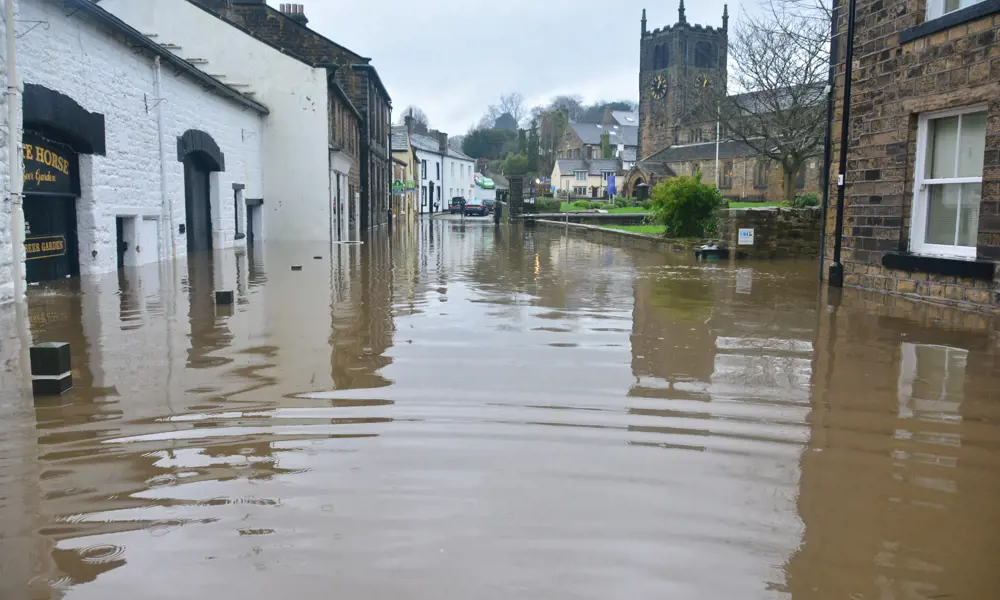
How do we make the UK more resilient to flooding?
It never rains. But it pours. This is misusing the proverb maybe, but it does feel appropriate, given recent weather. Recent weather means that we may, today, be worrying about water shortages, but the effects of climate change may be devastatingly felt in the form of flash flooding as high intensity rainstorms become more likely. As recently as early August, torrential rainfall after the dry weather caused flash flooding in parts of Devon, Cornwall, Somerset, and south Wales. Incidences of flooding have increased each year and it is now a regular pattern.
I chaired the Independent Expert Group (IEG) leading the London Flooding Review, which looked at the causes of the severe flooding in London in two days in July 2021. The flooding inundated hundreds of homes and businesses with water and sewage, and many residents were sadly still not back in their homes a year later. Rainfall overwhelmed the combined sewers, forcing sewage and water back up connecting pipes into dwellings and water was ejected from sewers that had reached capacity.
The IEG, which included Lykke Leonardsen, Head of Resilient and Sustainable City Solutions at the International Water Association, and Professor Roger Falconer FREng from Cardiff University – originator of many of the hydraulic models used for assessing flooding risk – sought information and anecdotes from the events to establish the best evidence and data set we could. Our investigation ran from early November 2021, supported by analysts and engineers from Mott MacDonald, and we issued our final report on findings and recommendations in July 2022.
Assessing the flood's impacts
It proved difficult to assemble all the necessary information. While we could access the Met Office rainfall radar data, Thames Water’s current sewer models for the affected areas and data showing the state of the Thames during the events, we never managed to get a complete and reliable set of reports of flooded properties. The different methods used and timescales adopted by the various parties to collect and manage the data meant that information was not available when we needed it. We used data we received, supplemented by anecdotal and video evidence from residents and social media, and took account of new data that arrived over the course of the study.
Given the ‘thin’ data set, we made wide use of sensitivity testing – the impact of variables on uncertain data – to assess our findings’ robustness and used a broadscale 2D model to show how water flowed around London at the surface. This enabled us to consider interaction between surface water and sewer systems.
One question from a resident particularly resonated. Badly shaken by the rapidity of the flooding she wanted to know whether the sewer system “had broken or wasn’t operated properly, which could be fixed” or whether the event was truly extreme; either way she might feel less scared of being flooded again.
Although return periods, which measure the likelihood of storms of this nature happening, vary for different areas and durations of rainfall, and each flooding event lasted different periods and covered separate areas, both were extreme with respect to current meteorological records: less than 1% Annual Exceedance Probability, meaning less than a one in 100 chance of happening in any year.
We also tested whether anything ‘was broken’, including pumping stations, flood alleviation schemes, road drainage gullies (grilles), sewer blockages, and the like, which could be fixed. Compared to the overwhelming amount of water that fell, none of the items we tested would have had a significant effect on the flooding levels – apart from tidal locking of sewers due to the state of the tide (where the level of the tide is sufficient to hold closed the flap valves through which the storm water flows to the river). An estimated 2.5 million m3 of rain fell on 12 July in two hours. This volume cannot be held in underground sewers – which are generally designed for one-in-30-year events; compare that with the Tideway Tunnel, which at more than 30 kilometres long and with a 7.2 metre diameter can hold less than 1.6 million m3.
Over decades more houses and impermeable areas such as car parks, paved areas and conservatories have been built, increasing both the amount of potential runoff and the numbers of houses at risk of flooding.
Water in extreme events must be managed safely on the surface; keeping excess water out of sewers reduces both the risk of sewage getting into properties and of sewage flowing into the Thames. Managing water on the surface means that Local Authorities (LA) – responsible as land planners and Lead Local Flood Authorities – have a significant role to play.
Large numbers of properties are at risk of flash flooding. Over decades more houses and impermeable areas such as car parks, paved areas and conservatories have been built, increasing both the amount of potential runoff and the numbers of houses at risk of flooding. Many people live in basements in London and here lives are at risk. Climate change may make this worse, so action is required to reduce risk for current and future residents and businesses. Without action, future flooding losses may not be covered by insurance, with severe social and economic impacts.
Water obeys topography and not administrative boundaries. We showed that even completely unblocked road gullies could not accept the surface flows that occurred, meaning water flowed downhill often from one LA area to another until it could enter a sewer or a house. A strategic approach is needed where LAs cooperate in the design, development, and management of surface water schemes.
Data, along with system modelling and land use policy, should be common and shared. Long-term prioritisation of schemes to offer the greatest benefit can then be undertaken and, with strategic oversight, multiple parties including LAs, water companies, developers, and other landowners may be brought together to be accountable for their obligations and provide more effective solutions to hold back the flow.
Engineers understand the impact of climate change on urban flooding, so the profession is in the ideal place to provide long-term solutions to address these challenges.
The Mayor of London has convened a Surface Water Management Strategy Group – a great step forward – to offer strategic oversight. Governance is being developed and this needs all of our support as governance allows funding to flow.
The Regional Flood and Coastal Committee has significant funds available for surface water management and wants larger strategic schemes brought forward to maximise effectiveness. A strategic approach would be welcomed.
Copenhagen’s experience, which put in place a climate change adaptation plan for urban flooding following extreme floods in 2011, shows safely managing this sort of event takes time, resolve, and significant investment. We must start the process now, dealing with current institutional obstacles and strategically directing flows of funding to reduce flows of water, or find ourselves in an ever-worsening and more difficult situation to reverse.
While this work proceeds, residents, particularly those in at-risk basements, need information and support to help understand and manage their situations. Engineers understand the impact of climate change on urban flooding, so the profession is in the ideal place to provide long-term solutions to address these challenges.
***
This article has been adapted from "New strategies needed for flood resilience", which originally appeared in Ingenia 92 (September 2022).
Contributors
Mike Woolgar has over 40 years’ experience in the water sector in the UK and internationally. His working life has been spent in the water, urban development, flood management, irrigation, and renewable energy sectors. In the UK he has worked on regulation, policy, advisory services, due diligence and expert services, and infrastructure project preparation in the regulated utilities, flood risk management, and resources sectors. He has extensive experience of infrastructure development including regulated and private sector water and waste systems, water resource planning, water systems development engineering, climate change, and sustainable energy.
Keep up-to-date with Ingenia for free
SubscribeRelated content
Environment & sustainability

Recycling household waste
The percentage of waste recycled in the UK has risen rapidly over the past 20 years, thanks to breakthroughs in the way waste is processed. Find out about what happens to household waste and recent technological developments in the UK.

Upgrade existing buildings to reduce emissions
Much of the UK’s existing buildings predate modern energy standards. Patrick Bellew of Atelier Ten, a company that pioneered environmental innovations, suggests that a National Infrastructure Project is needed to tackle waste and inefficiency.

An appetite for oil
The Gobbler boat’s compact and lightweight dimensions coupled with complex oil-skimming technology provide a safer and more effective way of containing and cleaning up oil spills, both in harbour and at sea.

Future-proofing the next generation of wind turbine blades
Before deploying new equipment in an offshore environment, testing is vital and can reduce the time and cost of manufacturing longer blades. Replicating the harsh conditions within the confines of a test hall requires access to specialist, purpose-built facilities.
Other content from Ingenia
Quick read

- Environment & sustainability
- Opinion
A young engineer’s perspective on the good, the bad and the ugly of COP27

- Environment & sustainability
- Issue 95
How do we pay for net zero technologies?
Quick read

- Transport
- Mechanical
- How I got here
Electrifying trains and STEMAZING outreach

- Civil & structural
- Environment & sustainability
- Issue 95